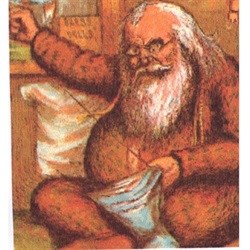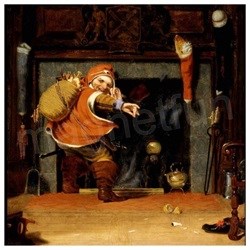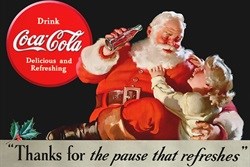In 1999, AdAge (USA) polled American marketers to determine the greatest advertising campaigns of the 20th century. The winner was 'Think Small', the campaign that introduced the USA to the Volkswagen Beetle in 1959. It was crafted by Doyle, Dayne, Bernbach.
The runner-up was 'the pause that refreshes', conceived for Coca-Cola in 1929 by Archie Lee of D'Arcy Co. Its enduring power comes from its timeless, almost poetic words; and from its adaptability to many human contexts. More than 85 years later, Coca-Cola is still 'a pause that refreshes.'
In my previous article, I looked at how a brand becomes mentally available - that is - how it gets to be the first brand that comes to mind when a person faces a choice. I noted that advertising is one way to build availability. In this article I'll use 'the pause' to show how it can be done.
Our story begins back in the 19th century. Consider the pictures below.
On the left: Santa Claus from the 1880's. He's a grumpy old man wearing a muddy brown suit. He has to be capable of 'grumpy' - otherwise he wouldn't be credible as someone who might not give you your presents.
On the right: he's just about to go back up the chimney. He's small. That's how he gets up and down chimneys. His suit is redder and whiter than in the first picture, but only just. He's cheerful because the children in this household are getting presents.
From its inception, The Coca-Cola Company understood that it was a challenge to sell Coke in winter. In 1922 Archie Lee helped with his first great slogan: 'thirst knows no season'. The campaign ran for a number of years featuring pictures of people skiing and drinking Coke. But it was only when Lee came up with 'the pause that refreshes' that he had the ingredients to craft the perfect winter campaign. He hooked 'the pause' into Santa; and the rest is advertising history.
It had become a tradition for children in the USA to leave a glass of milk on the mantelpiece for Santa. After all, Santa might need refreshment on his way around the world. What better than milk? Well... if you were a creative genius like Archie Lee you might wonder 'why not Coke?' Lee recruited an artist called Haddon Sundblom to paint the pictures. The result was a series of images that made Sundblom famous.
And so Santa became definitively cheerful. He became fully human. He became everyone's favourite grandfather. He wore Coca-Cola colours. And he was over-joyed to find Coke on the mantelpiece. Santa's image in the USA had been moving in this direction through the 19th and early 20th centuries. The Lee-Sundblom campaign nailed it and added Coke to the mix.
People built great tombs and temples before Newton came along. And Archie Lee and Haddon Sundblom crafted great advertising before we understood the neural processes that give advertising its power. A brief reminder from my last article may be in order. The brain is a massively interconnected memory-prediction engine. By linking likes and dislikes to memories in contexts, it develops preferences about what to do when those contexts re-occur. If a brand is part of the mix, then the brand becomes mentally available in that context. And so, when the context comes along, the brand pops to mind.
Let's turn our attention now, to the ways in which this campaign leverages this. First: a potent network of affective memories already existed in popular American culture. And although Santa is the center of the scene, it isn't just about him. It's about cute children, happiness, celebration, giving and receiving gifts, everyone's favourite grandfather; and winter. The device is Santa, but pre-existing neural networks ensured that the imagery resonated across multiple contexts.
Second, the ads don't invite a logical argument. Your brain doesn't jump to attention and wonder if this is true or false, right or wrong. It simply dwells on the images and soaks them up... consciously or unconsciously... with Coke embedded in every scene.
Third, Lee and Sunblom understood the importance of repetition (as did most professional marketers back then). What the brain sees together, it puts together. Coke co-opts the associations just by being there.
Robert Heath of the University of Bath has written eloquently about the power of advertising that doesn't set out to persuade, but that works through the implicit association of the brand with emotionally engaging imagery. He calls this 'low attention processing'. But by 'low attention' he doesn't mean 'unengaging'. This is advertising that leaves deep neural tracks. It's very different from Barnard and Ehrenberg's idea that advertising is just 'publicity'.
More than most, The Coca-Cola Company has understood the importance of both physical and mental availability. So the fact that Coke reigned for many years as the world's most valuable brand, isn't just down to its advertising. On balance I'd say that physical availability played the bigger of the two roles. But Coca-Cola has given us some of the world's best advertising.
Summary: One of the ways in which great advertising works is by co-opting pre-existing memories and contexts; and shaping the brand to them. Examples like the Lee-Sundblom campaign suggest that this works best when the brand finds a way to be part of the contextual mix without trying to persuade. The formula is simple: show the brand in the desired contexts in an emotionally positive and disarming way. Then repeat. Do not tire of repeating. In this way, adverts that are not overtly trying to persuade, become immensely persuasive. Tracks form in the brain; and the brand jumps to mind in contexts. This is what I mean by mental availability.











































